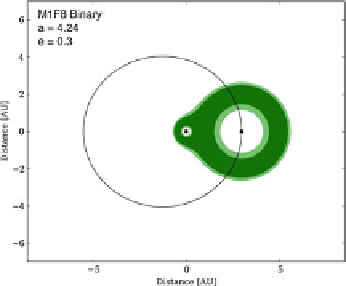Geoscience Reference
In-Depth Information
Fig. 13.14
Boundaries of the narrow (
dark green
) and empirical (
light green
)HZsinanF8-M1
binary. Note that the primary is the M1 star at (0,0). The panels show the effect of the F8 star whilst
orbiting the primary starting from the
top left panel
when the secondary is at the binary periastron.
The semimajor axis of the binary has been chosen to be the minimum value that allows the region
out to the outer edge of the primary's empirical single-star HZ to be stable for a binary eccentricity
of 0.3
assuming the binary eccentricity to be 0.3. Figures
13.14
and
13.15
show the results
for four different relative positions of the two stars. In Fig.
13.14
, the primary is
the M star and in Fig.
13.15
, the primary is the F star. As shown in these figures,
when the secondary is more luminous, it will have considerable effects on the shape
and location of the single-star HZ around the other star. However, a cool and less
luminous secondary will not change the limits of the primary's single-star HZ.
13.8.1
Habitable Zone of
˛
Centauri
The Ǜ Centauri system consists of the close binary Ǜ Cen AB and a farther
M dwarf companion known as Proxima Centauri at approximately 15,000 AU.
The semimajor axis of the binary is
23.5 AU and its eccentricity is
0.518. The










































































































































Search WWH ::

Custom Search